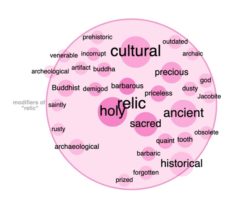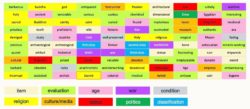06
03
.24
Unravelling Layers of Meaning: Relics in Contemporary Discourse
Written by Dr Emma McClaughlin
Hybrid Relics is a Horizon Agile Round 3 project, which focusses on musical instruments, and secular, and religious relics to consider social computing and the creation of hybrid products from a fresh perspective. Hybrid products seamlessly blend physical elements with digital interfaces or functionality to enhance user experiences. Part of the project was to take an interdisciplinary approach. The project team is bringing together design, digital humanities and computer science.
“We thought that this was really important, and that one of the ways that we might initially explore the term “Relic” was for Dr McClaughlin to carry out some research using corpus analysis on the term. Relic is one of those tricky words that has different meanings for different people and can be interpreted in all kinds of ways.” Dr Alan Chamberlain, Principal Investigator
To support the project team in understanding and reflecting on the contemporary status of relics, Emma McClaughlin is looking into the how the term ‘relic’ has been used in language use. She has examined a digital body of texts containing over 52 billion words of English language from the 2021 web—the enTenTen21 corpus. The analysis unveiled the prominence of relics along with the social value attached to them in contemporary language use. She has considered instances where the word ‘relic’ features in religious, secular, and metaphorical contexts; the kinds of objects that are described as relics; the status of relics and the importance attributed to them; and the different ways in which relics are evaluated and classified.
The data and analytical tools used in this study were made available via Sketch Engine corpus analysis software.[1]
What is corpus linguistics?
Corpus linguistics is an analytical approach, which draws on specialist software to identify common patterns that occur in language use, including the frequency and usage of specific words.
A corpus (plural corpora) is a digitised body of texts, which can be exploited using corpus linguistic software to identify language features such as (i) frequency, (ii) parts of speech (nouns, verbs, adjectives etc.); (iii) keywords (words appearing statistically more frequently – or infrequently – in a target corpus compared with a reference corpus); (iv) collocation (words which co-occur in a statistically salient way; and (iv) concordance lines (extracts of text showing a search term in context).
Understanding Relics in Context
The enTenTen21 corpus contains 265,970 instances of ‘relic’ (4.32 instances per million words). Modifiers of a word can provide extra information about the thing being described. For our purposes, modifiers of the word ‘relic’ can reveal something of the status or appearance of relics, as well as evaluations, which can tell us about the way relics are considered.
The figure below shows a visualisation of this analysis called a ‘Word Sketch’. Here, the search term (‘relic’) is shown in the centre and a selection of modifiers that habitually co-occur with it are shown in the surrounding nodes. The size and colour density of the nodes indicate relative frequency and the proximity to the search term in the centre shows the strength of association.

Word Sketch visualisation showing a selection of modifiers for the noun ‘relic’ in the enTenTen21 corpus
The table below shows the top 100 modifiers of relic. They have been broadly classified and colour coded by meaning. Modifiers frequently denote the religious significance, age, condition, status, value, and evaluation of the character of relics. A small number of illustrative examples are shared below.

Top 100 modifiers of relic in the enTenTen21 corpus
Religious and cultural significance
Several strands of meaning can be found in the way relics are discussed in contemporary online texts. First, the traditional, religious sense of the word ‘relics’ is represented in the corpus. Here, relics are often framed in terms of their being desirable things to travel to see or as holding particular value for attracting visitors to a place. Though this is a diminished part of the way relics are represented linguistically compared with historical representations, it illustrates that religious relics still hold significance as symbols of cultural heritage, which serve as a tangible reminder of the past events, traditions, and identities, and religion and spirituality. This links closely with another prominent pattern of representation where relics are framed as lost things to seek and find.
‘The shrine is a place of pilgrimage housing two first-class relics of St. John Paul II’
‘Leominster’s early history as an important religious centre and repository of saintly relics is explored’
‘Its great castle is a fascinating relic of the mysterious Templars, full of secret passages, symbolic paintings, and compelling art.’
‘visitors can explore fascinating relics of the lost Gaelic kingdom of Dál Riata’
Negative meaning
Metaphorical use of the word relic is a big part of contemporary language use in political contexts. Where political movements, beliefs, and periods are described as ‘relics’, these are considered to be negative.
‘Right to work is a Jim Crow relic that was specifically designed to keep White and Black workers apart, playing on our worst fears’
‘many wonder why Bond is still a thing, given that he’s both a Cold War relic and an outdated symbol of masculinity’
Outside of a metaphorical sense, the word ‘relic’ can take on negative meaning from the modifiers it habitually co-occurs with (e.g., ‘useless’, ‘fading’, ‘dusty’, ‘rusty’) particularly when used to describe non-religious or modern items, such as cars.
‘To our great-grandchildren, the horror of the Holocaust may become a dusty relic of antique memory, much as the Spanish Inquisition is to us’
‘The Ultima is a modern car, not some dusty ’90s relic’
‘I bought a Synology NAS and now am looking at Dropbox as a useless relic’
‘Tonsils were routinely cut out of children’s throats under the assumption they were useless relics of our evolutionary past’
Bridging the physical and digital
In this digital age, relics are no longer confined to physical artifacts. The analysis highlighted how descriptions of relics, once predominantly associated with tangible objects like bones or architecture, now have significance as digital entities in gaming contexts. This evolution illustrates the impact of technology on our perceptions of cultural relics in an increasingly digitised world.
Timeless appeal
The corpus linguistic study has shed light on the multifaceted meanings attributed to relics in contemporary language usage. In doing so, it has provided invaluable insights into their social and cultural significance. From religious reverence to metaphorical symbolism, relics continue to captivate the human imagination, bridging the past with the present and the physical with the digital. As language evolves, so too does our understanding of relics, reaffirming their timeless appeal in culture and discourse.
Find out more about the Hybrid Relics project
[1] Kilgarriff, A., Baisa, V., Bušta, J., Jakubíček, M., Kovář, V., Michelfeit, J., Rychlý, P., & Suchomel, V. (2014). The Sketch Engine: ten years on. Lexicography, 1(1), 7-36.
Tags:
artifact,
corpus linguistics,
digital,
relics
















